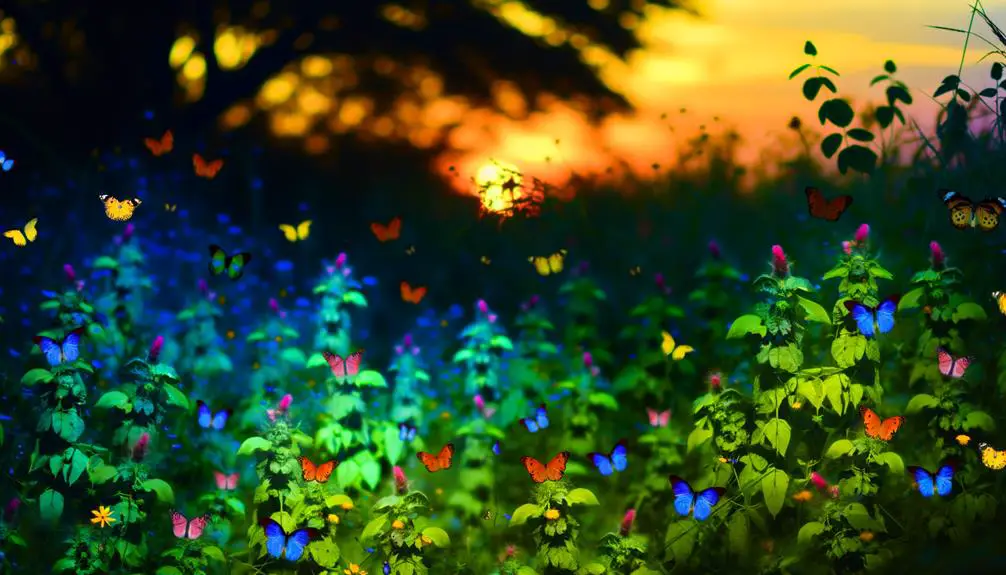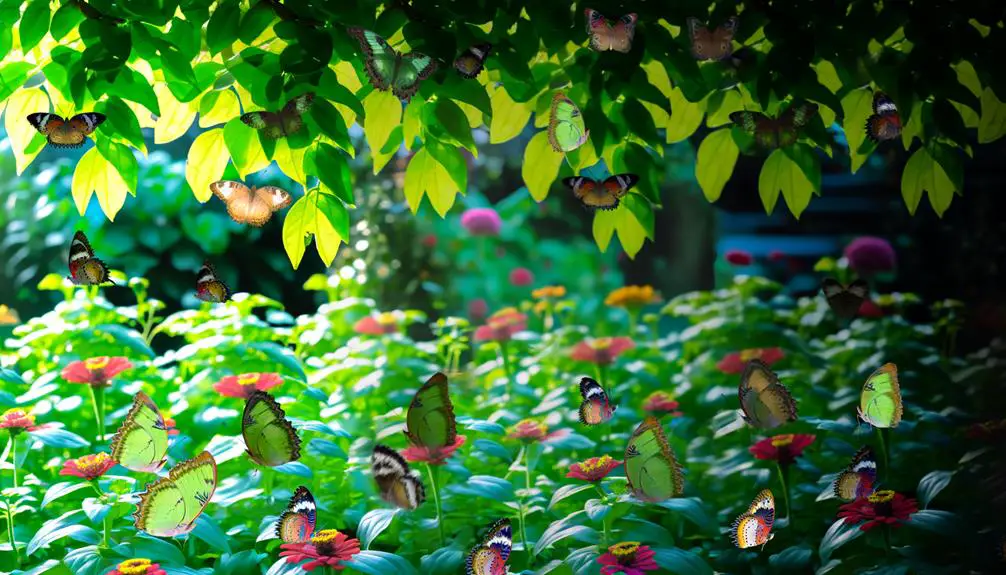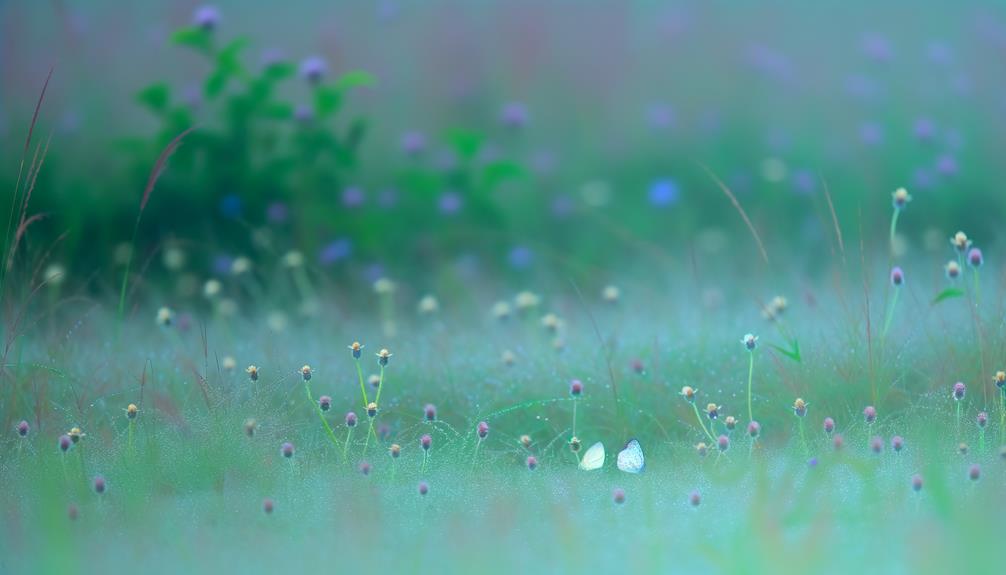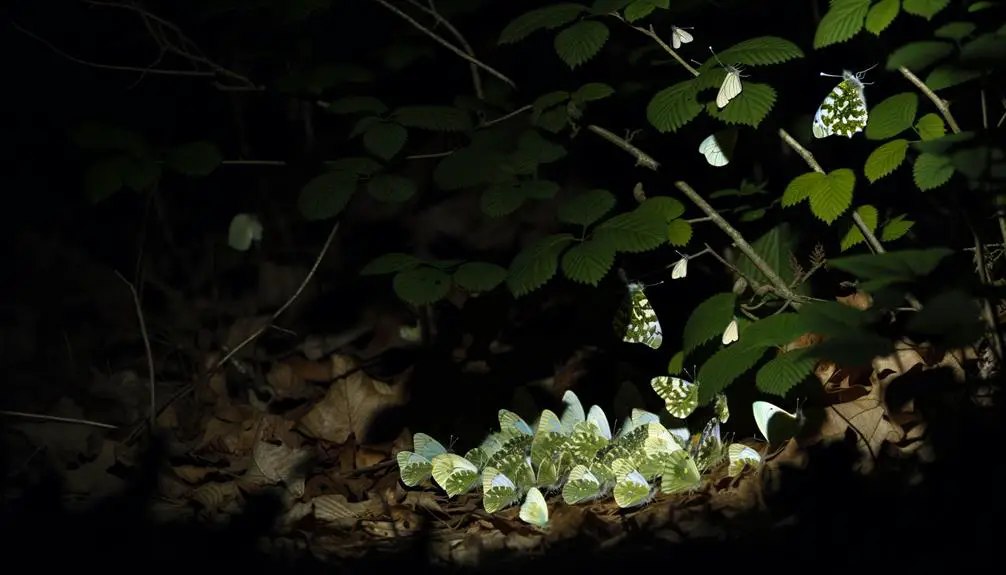Where Do Butterflies Sleep: Finding Their Resting Spots
Butterflies, being ectothermic, enter a state of torpor to conserve energy during cooler temperatures. They choose specific nighttime hiding spots such as the undersides of leaves, tree bark crevices, and dense vegetation to minimize detection by predators and maintain stable microclimates.
Bark and tree crevices provide camouflage and moisture retention, while leaves and flowers offer protection from rain and wind. Grass and ground cover further aid in temperature regulation and predator avoidance.
These carefully selected microhabitats enhance their survival chances by providing ideal conditions. With this understanding, one can appreciate the intricate survival strategies butterflies employ.

Key Takeaways
- Butterflies sleep under leaves, in tree bark crevices, and amidst dense vegetation for protection from predators and environmental stressors.
- They enter a state of torpor at night, reducing their metabolic rate to conserve energy and maintain temperature stability.
- Grass and ground cover provide essential microclimates and concealment, aiding hydration and temperature regulation during sleep.
- Specific plants like milkweed, goldenrod, and asters are preferred for their dense foliage and natural camouflage benefits.
Butterfly Sleeping Habits

Examining the sleeping habits of butterflies reveals a fascinating aspect of their daily biological rhythms and survival strategies.
Butterflies, being ectothermic creatures, are heavily influenced by temperature and light. They exhibit a behavior known as torpor, a state of reduced physiological activity, to conserve energy during the night.
During torpor, their metabolic rate drops considerably, allowing them to survive cooler nighttime temperatures and periods of inactivity. This state is essential for maintaining their energy levels, as butterflies rely on warmth from sunlight for their daily activities.
The timing of this torpor is tightly regulated by their circadian rhythms, ensuring that they are inactive during the night and active during the day, optimizing their energy utilization and survival.
Nighttime Hiding Spots
Butterflies select specific nighttime hiding spots that provide ideal protection from predators and environmental stressors, often choosing locations that offer camouflage and shelter. These spots include the undersides of leaves, crevices in tree bark, and within dense vegetation. By remaining motionless and closing their wings, butterflies further enhance their ability to blend into their surroundings. Observers interested in how to spot butterflies in their hiding places should look carefully at shaded areas with dense foliage or inspect the undersides of leaves for subtle wing patterns. Early morning, when butterflies are still inactive from the cool night, can be an ideal time to locate them in their concealed resting spots.
The choice of such locations is essential for minimizing detection by nocturnal predators like bats and owls. In addition, these hiding spots offer a stable microclimate, which helps maintain the butterfly's body temperature and reduces the risk of desiccation.
Moreover, some butterflies exhibit geotaxis, the tendency to orient themselves in a particular direction, aiding in their selection of secure resting sites. By utilizing these strategies, butterflies enhance their survivability during vulnerable nighttime periods.
Leaf and Flower Shelters

Butterflies utilize leaf and flower shelters for their natural camouflage benefits, which help them evade predators during their inactive periods.
These shelters also provide essential protection from adverse weather conditions, such as rain and wind.
Specific plant choices are preferred by different butterfly species, optimizing their survival through tailored environmental adaptations.
Natural Camouflage Benefits
The natural camouflage benefits of leaf and flower shelters play an essential role in the survival of butterflies by providing effective concealment from predators.
Butterflies often utilize the intricate patterns and colors of leaves and flowers to blend seamlessly into their surroundings. This form of cryptic coloration reduces visibility to predators such as birds and lizards.
Additionally, the structural complexity of these natural shelters offers physical hiding spots, making detection more challenging.
The selective pressures of predation have driven butterflies to evolve specific resting postures and wing patterns that mimic their habitats.
This adaptive behavior enhances their chances of survival by minimizing predation risk during vulnerable periods, such as rest or sleep, thereby contributing considerably to their overall fitness and longevity.
Weather Protection Tactics
Leaf and flower shelters serve as vital microhabitats, offering butterflies protection from adverse weather conditions such as rain, wind, and extreme temperatures. These natural refuges are essential for their survival, aiding in thermoregulation and reducing vulnerability to predators during rest periods.
The structural complexity and dense foliage of these shelters provide several advantages:
- Rain Protection: Leaves and petals act as natural umbrellas, shielding butterflies from getting drenched.
- Wind Breaks: Dense foliage mitigates wind impact, preventing dislodgement and energy loss.
- Temperature Regulation: Sheltered spots maintain more stable microclimates, reducing temperature extremes.
Understanding these tactics is fundamental in appreciating the intricate relationship between butterflies and their habitats.
Preferred Plant Choices
Selecting specific plants with dense foliage and complex floral structures is essential in providing effective shelters for butterflies during adverse weather conditions.
Plants such as milkweed (Asclepias spp.), goldenrod (Solidago spp.), and asters (Aster spp.) offer both the necessary cover and the added benefit of nectar sources.
Dense, multi-layered shrubs like oakleaf hydrangea (Hydrangea quercifolia) and butterfly bush (Buddleja davidii) create microhabitats where butterflies can roost safely.
Additionally, evergreen species like holly (Ilex spp.) and conifers provide year-round protection.
These plants not only shield butterflies from wind and rain but also help regulate temperature, ensuring a stable environment for rest.
Selecting a variety of these plants fosters a resilient habitat conducive to butterfly conservation.
Bark and Tree Crevices
Butterflies frequently utilize bark and tree crevices as preferred natural shelters, taking advantage of the protection these structures offer against predators and environmental stressors.
This behavior underscores the strategic importance of microhabitats in their survival, providing both camouflage and physical barriers.
Studying these preferences provides valuable insights into the adaptive strategies butterflies employ to enhance their chances of survival in diverse ecosystems.
Natural Shelter Preferences
The propensity of butterflies to seek refuge in the intricate textures of bark and the hidden recesses of tree crevices is a behavior driven by the need for protection from predators and environmental elements. This preference is influenced by several factors:
Microclimatic Stability: Tree bark and crevices provide a stable microenvironment, shielding butterflies from temperature fluctuations and desiccation.
Camouflage: The complex patterns and textures of bark offer excellent camouflage, making butterflies less visible to predators.
Humidity Regulation: The moisture retained within tree bark helps in maintaining the hydration levels necessary for butterfly survival.
Reduced Wind Exposure: Tree crevices and bark offer a barrier against strong winds, reducing the risk of physical harm.
These natural shelters are essential for the nocturnal and overwintering phases of butterfly life cycles.
Survival Strategy Insights
Given the myriad benefits offered by tree bark and crevices, it becomes evident that these natural shelters play a pivotal role in the survival strategies of butterflies, particularly in mitigating predation risks and environmental stressors. Tree bark provides a textured surface, allowing butterflies to camouflage effectively, reducing visibility to predators. Additionally, crevices offer protection from harsh environmental elements such as wind and rain, ensuring ideal microclimatic conditions for rest.
| Benefit | Description |
|---|---|
| Camouflage | Textured surface aids in blending with surroundings |
| Predation Mitigation | Reduced visibility to natural predators |
| Environmental Shield | Protection from wind, rain, and extreme temperatures |
These shelters exemplify the intricate adaptations butterflies employ to enhance their survival and longevity in diverse ecosystems.
Grass and Ground Cover

Although often overlooked, grass and ground cover play an essential role in providing suitable resting sites for butterflies during their sleep cycles. These habitats offer numerous advantages that cater to the physiological and ecological needs of these insects.
Key benefits of grass and ground cover include:
- Microclimate Regulation: Dense vegetation helps maintain stable temperatures and humidity levels.
- Predator Avoidance: Thick grass and ground cover provide concealment from predators.
- Moisture Retention: Ground cover conserves moisture, essential for butterfly hydration.
Understanding these elements elucidates how grass and ground cover contribute greatly to the survival strategies of butterflies, ensuring they have safe and suitable environments to rest during vulnerable periods.
Climatic Influences
Climatic factors play a pivotal role in determining the resting and sleep patterns of butterflies, influencing their behavior, physiology, and habitat selection.
Temperature and humidity are primary determinants; butterflies seek microhabitats that offer ideal thermal conditions to conserve energy and avoid desiccation.
Diurnal temperature variations impact their metabolic rates, necessitating specific resting sites such as shaded leaves or crevices that provide thermal stability.
Rain and wind also affect their choice of resting spots, prompting butterflies to find shelter under dense foliage or within tree bark to avoid adverse weather.
These climatic influences are critical for maintaining homeostasis, enabling butterflies to survive and thrive in varying environmental conditions.
Understanding these factors is essential for conservation efforts and habitat management strategies.
Predation and Safety

Butterflies' resting behavior is greatly influenced by the need to minimize predation, leading them to select concealment sites that offer ideal camouflage and reduce the likelihood of detection by predators.
Their choice of roosting locations is strategic, often influenced by several key factors:
- Cryptic coloration: Butterflies rest on surfaces that match their wing patterns, blending seamlessly with the environment.
- Elevated positions: Perching on higher vegetation reduces ground-level predation risks.
- Undersides of leaves: This position not only hides them but also provides shelter from the elements.
Conclusion
In the intricate dance of nature, butterflies exhibit a fascinating array of nocturnal habits.
Their choice of nighttime refuge—ranging from the delicate embrace of leaves and flowers to the rugged sanctuaries of bark and tree crevices—demonstrates an adaptive brilliance shaped by climatic influences and predation pressures.
These ethereal creatures find solace in grass and ground cover, weaving a tapestry of survival strategies that underscore their resilience.
This symphony of behaviors highlights the complex interplay between environment and evolutionary ingenuity.





